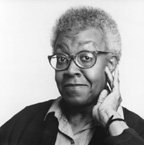 |
||
  |
||
|
|
The Impact of a Poem's Line Breaks: Enjambment and Gwendolyn Brooks’ “We Real Cool”IntroductionPerhaps to her dismay as a voluminous, Pulitzer Prize-winning poet and former Consultant in Poetry to the Library of Congress, Gwendolyn Brooks is best known for her short but far-reaching poem "We Real Cool." The poem's beauty, strength, and power are rooted in its effective use of line breaks. Brooks' strategic choice of line breaks affects virtually every aspect of the poem: its pace, rhythm, mood, tone, characters, sound, and meaning. In this lesson, students will closely analyze the poem's line breaks and the effect of enjambment on their reading and interpretation of the poem.Guiding Question
Learning ObjectivesAfter completing this lesson, students will be able to:
Preparing to Teach This Lesson
Suggested Activities1. Listening to Gwendolyn Brooks2. Analyzing Line Breaks1. Listening to Gwendolyn BrooksIntroduce students to Gwendolyn Brooks by providing some details of her life and place in literary history, drawing from the following links available via the EDSITEment-reviewed Academy of American Poetry:
If students read this poem at home before class discussion, consider handing out these questions, available in PDF format, for students to complete at home. If students are encountering the poem in class, ask them to consider the following questions:
The 'We'—you're supposed to stop after the 'We' and think about their validity, and of course there's no way for you to tell whether it should be said softly or not, I suppose, but I say it rather softly because I want to represent their basic uncertainty, which they don't bother to question every day, of course." (From critical essays from the EDSITEment-reviewed Modern American Poetry website.)Ask students the following questions:
2. Analyzing Line BreaksThe beauty, strength, and power of this poem are rooted in the poem's effective use of line breaks and enjambment. Review with students the definition of enjambment at LitWeb, available online via the EDSITEment-reviewed Academy of American Poets:Perhaps the best way for students to understand the impact of the poem's line breaks is to reconfigure the poem and disrupt the use of enjambment. Ask students to rewrite the poem as in prose form, placing all "we" sentences on the same line. They should not use any stanzas but should instead write the poem in one "block" piece of prose, such as: We real cool. We left school. We lurk late (etc.)Note: these activities can be accomplished in a variety of ways, depending on class size and configuration. One student can transcribe the poem on the blackboard and the class can engage in one large conversation, or you might consider breaking students into groups for this activity. Likewise, if more than one computer is available, consider asking students to copy and paste the poem into a word processing program and using it to rearrange the stanzas and line breaks. Ask for two student volunteers to read the new prose poem, and then ask students to discuss the following questions:
We real cool.Read this version, and then ask students to analyze this rendition of the poem:
Assessment
Extending the LessonAnother way for students to understand the power and poetic effect of line breaks is to have them turn their own prose poems into poems that rely heavily of line breaks to convey meaning and move an audience. Divide the class into 4-5 small groups. Have each group work together to write a prose poem about a group of people that they associate with, such as members of an academic or athletic club, band members, and so on (students should write about themselves to hopefully avoid any tone of mocking another group of people). After each group has "perfected" its prose poem, have each group turn the poem into a poem with 5, 2-3 line stanzas. Point out that students can rearrange the word order and change a word or two if necessary to create their final poem. Have each student write a brief analysis of the difference between their group's prose poem and revised, 5-stanza poem. In the analysis, students should answer the following question: "How does your group's choice of line breaks affect the tone, pace, rhythm, and thematic impact of the poem?" Selected EDSITEment Websites
Standards Alignment View your state’s standards |
||||||||||||||||||||||||||||||||||||||||||||||||||||||||||||||
  |
||
| EDSITEment contains a variety of links to other websites and references to resources available through government, nonprofit, and commercial entities. These links and references are provided solely for informational purposes and the convenience of the user. Their inclusion does not constitute an endorsement. For more information, please click the Disclaimer icon. | ||
| Disclaimer | Conditions of Use | Privacy Policy Search
| Site
Map | Contact
Us | ||
